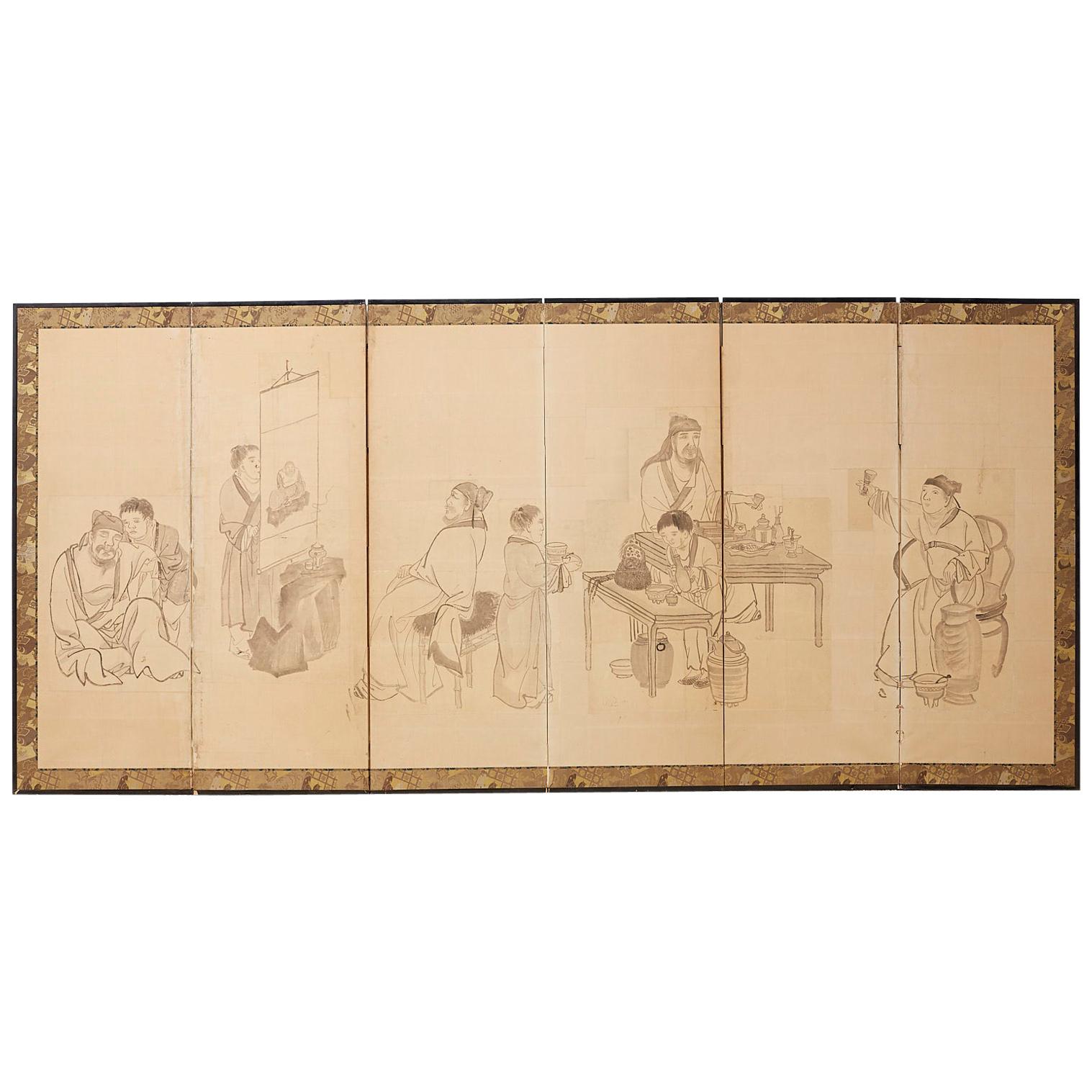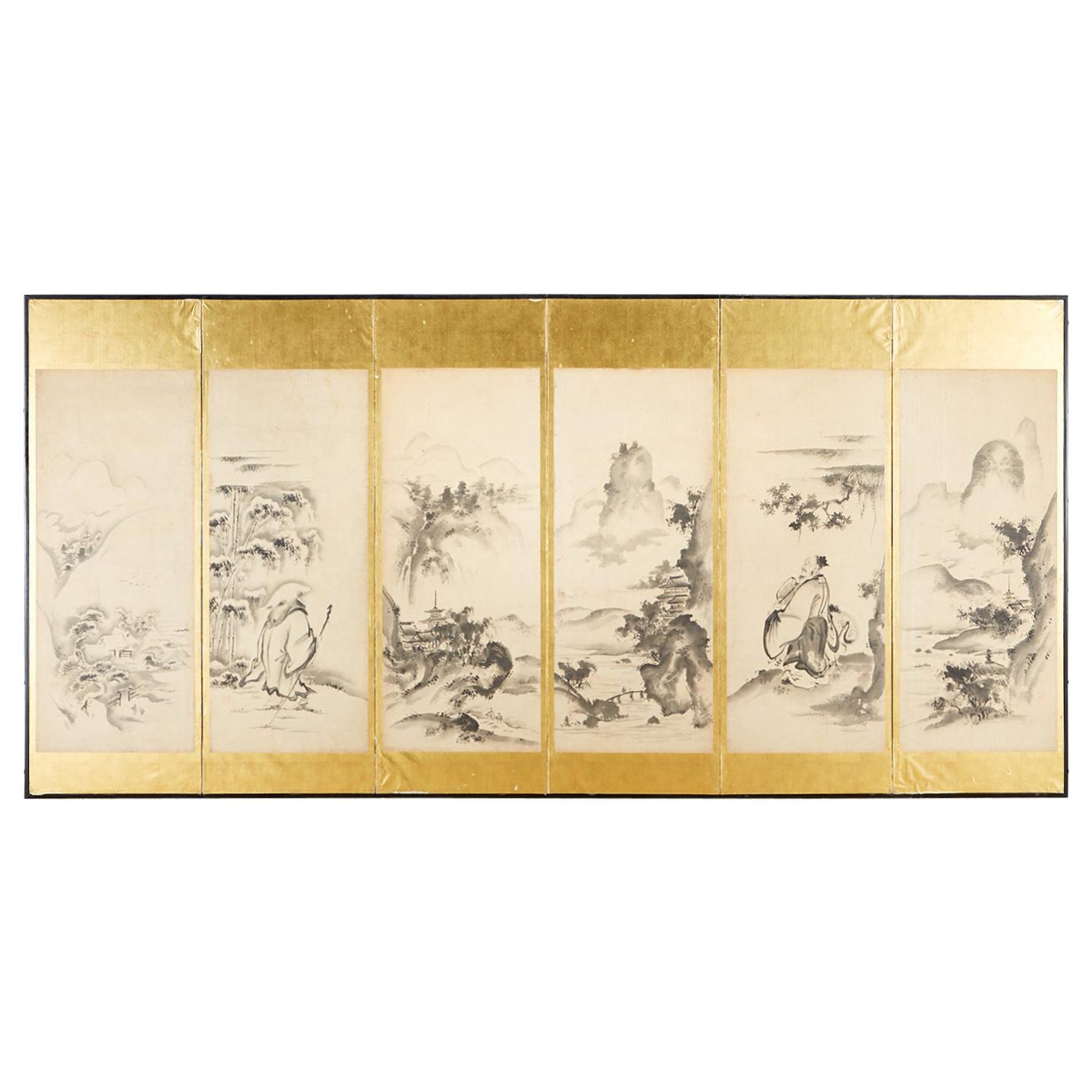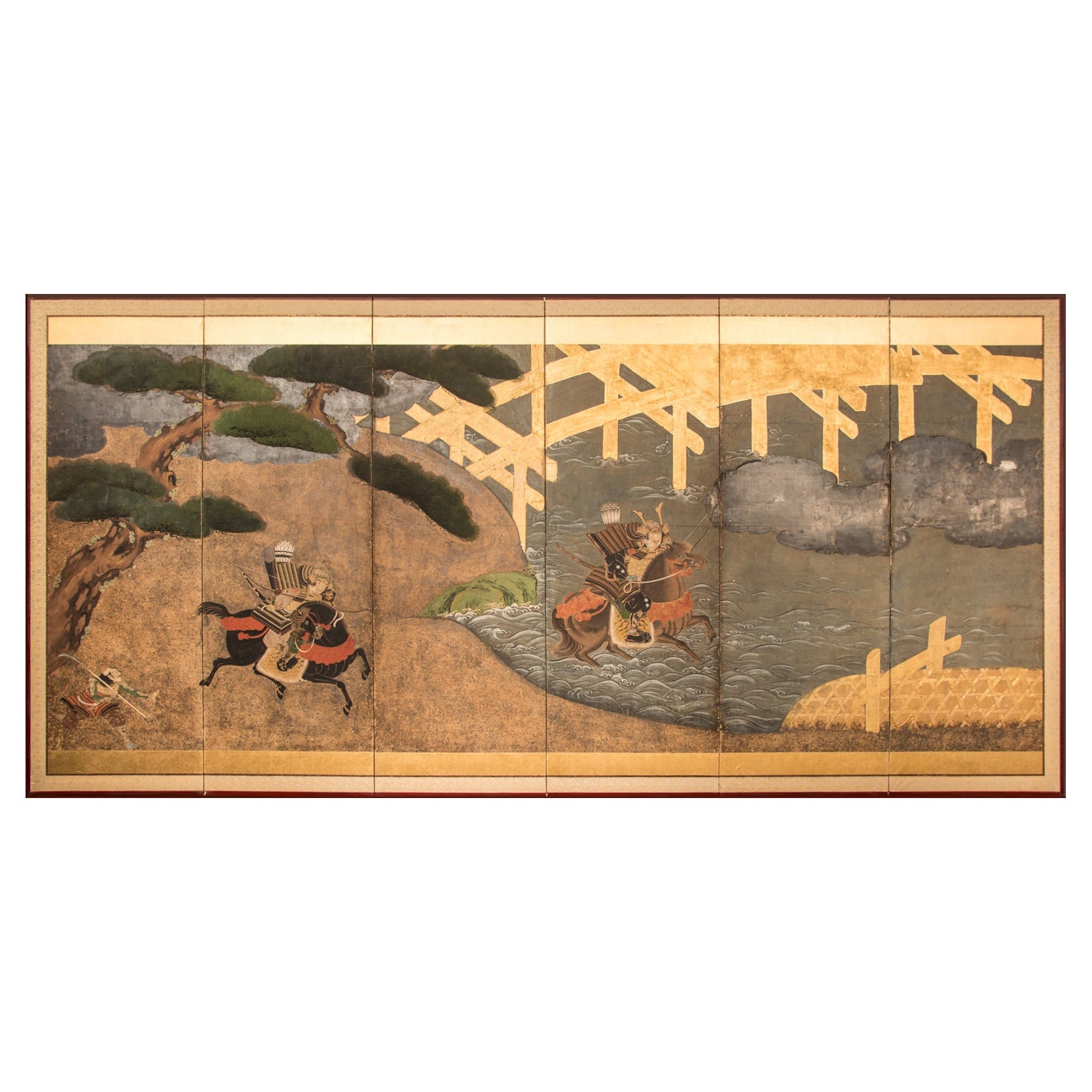Items Similar to Set of Six Japanese Ido Period Shunga 'Erotica' Hanging Lacquered Wood Panels
Want more images or videos?
Request additional images or videos from the seller
1 of 21
Set of Six Japanese Ido Period Shunga 'Erotica' Hanging Lacquered Wood Panels
About the Item
These magnificent lacquered wood panels have been mounted together on a lucite panel. Each panel has its original hanging handle. The panels are hanging on antique railroad pins that have been cut and attached to the lucite panel. It has been framed with a double molding, which is made up of a black lacquered wood molding and a walnut burl wood molding. Shunga is a style that was painted by some of the best ukiyo-e artists of the day, including Kitagawa Utamaro and Katsushika Hokusai (Hokusai’s most famous shunga, which features some octopus-on-woman action, was the subject of a 1981 film titled ‘Edo Porn’). Shunga was in demand, and one commission from a wealthy buyer would reportedly keep an ukiyo-e artist eating for months. One, ahem, standout element of shunga is the exaggerated genitalia. This flourish was not, in fact, ukiyo-e artists bragging about the size of their, uh, brushes, but rather an expression of the genitalia as a ‘second face’, one that, unlike the face presented to the public every day, represents one’s true primal desires – hence both the similarity in size and often unnatural physical proximity to the noggin’. Another unique shunga element: both partners are usually fully (well, almost fully) clothed. Unlike in the West, where bare flesh was seen as simultaneously tantalising and taboo, men and women of Edo-era Japan saw each other in the nude regularly at mixed baths and the like. If anything, it was more appealing to see men and women in shunga clothed, as it helped to identify the characters’ walk of life and to emphasise the parts that were exposed (as if they needed any more emphasising). Shunga was widely accepted in the Edo period, owned and displayed by both men and women. Reports from early foreign visitors to Japan describe visits to Japanese homes in which the man and wife of the house proudly show off their shunga collections to their horrified Western guests. The de-shunganisation of Japan came in the Meiji period. Opening itself up to the Western world after centuries of isolation, the Japanese government sought to bring the country in line culturally and morally with the ‘civilised’ West, banning shunga (not to mention fun practices like public nudity and mixed-gender bathing). Police raids in the early 1900s led to the confiscation and destruction of thousands of pieces, and shunga, though no longer banned outright, has remained taboo since. Ironically, it’s again Western influence that’s changing Japanese attitudes towards shunga – this time toward a positive re-evaluation. Many 20th century Western artists have cited the influence of shunga on their work (Picasso liked Hokusai’s aforementioned octopus-starrer so much he painted his own version), helping legitimise the form in the West while it was simultaneously being banned in Japan. More recently, over the past decade there have been major exhibitions of shunga in Helsinki, Milan and Barcelona, culminating in the 2013 exhibition at the British Museum that serves as the basis for Tokyo’s, which ‘The Independent’ praised as being ‘the most explicit and brilliant pictures of pleasure ever produced’.
- Dimensions:Height: 53 in (134.62 cm)Width: 67 in (170.18 cm)Depth: 2 in (5.08 cm)
- Sold As:Set of 9
- Style:Edo (Of the Period)
- Materials and Techniques:
- Place of Origin:
- Period:
- Date of Manufacture:18th Century
- Condition:Wear consistent with age and use. Minor losses. Minor structural damages. Minor fading.
- Seller Location:North Miami, FL
- Reference Number:1stDibs: LU6132226826132
About the Seller
3.0
Vetted Seller
These experienced sellers undergo a comprehensive evaluation by our team of in-house experts.
Established in 2000
1stDibs seller since 2021
12 sales on 1stDibs
Typical response time: Several days
- ShippingRetrieving quote...Ships From: North Miami, FL
- Return PolicyA return for this item may be initiated within 2 days of delivery.
More From This SellerView All
- “Abundantia”, Oil on Panel, Attributed to Angelica 'Maria Anna' KauffmanBy Angelica KauffmannLocated in North Miami, FLBehold "Abundantia," an oil masterpiece on panel, often attributed to the accomplished artist Angelica (Maria Anna) Kauffman (Italian/English, 1741-1807). This remarkable work of art...Category
Antique 18th Century Italian Paintings
MaterialsWood, Paint
- 17th Century Italian Flemish Oil on Canvas Painting of Adoration of the MagiLocated in North Miami, FL17th Century Italian Flemish oil on canvas painting depicting the Adoration of the Magi. Early Flemish painting was contemporary to the development of the early Renaissance in Italy. In the middle of the 15th century Italy...Category
Antique 17th Century Italian Baroque Paintings
MaterialsWood, Giltwood, Paint
- The Vision of Saint Hubertus, Late 17th CenturyLocated in North Miami, FLLate 17th century oil on joined wood panel interpretation of The Vision of Saint Hubertus by Albrecht Durer. It was painted in 1501 and became a very po...Category
Antique 17th Century German Baroque Paintings
MaterialsAcrylic, Lucite, Wood, Paint
- Virgin of the Immaculate Conception, 16th Century, Oil on CanvasLocated in North Miami, FL16th Century Spanish Colonial Oil on canvas painting of the Virgin of the Immaculate Conception. In this representation of the Virgin Mary being f...Category
Antique 16th Century Spanish Spanish Colonial Paintings
MaterialsCanvas, Wood, Paint
- Painting of an Italian Girl in a Mountain Landscape, Early 20th CenturyLocated in North Miami, FLEarly 20th Century Oil on Canvas of an Italian girl in a mountain landscape painted by Carl Forup, a pupil of Henri Matisse. Circa 1930.Category
Early 20th Century Danish Modern Decorative Art
MaterialsSilver Leaf
- 1920s Carved-Wood Panel of Part of the Frieze of the ParthenonLocated in North Miami, FL1920s French walnut carved-wood panel of part of the Frieze of the Parthenon. It shows the procession of the Panathenaic festival, the commemoration of the birthday...Category
Early 20th Century French Decorative Art
MaterialsWood, Walnut
You May Also Like
- Pair of brown Lacquer on Wood Panels Art Nouveau Floral Japanese Style .Located in Miami, FLTwo Lacquer panels on wood Japanese inspiration soft colors , floral theme. Style Art Nouveau// Art Deco. French origine. Could fit perfectly above a pair of Art Deco or art Nouveau ...Category
Mid-20th Century French Art Nouveau Paintings
MaterialsWood
- Japanese Edo Period Six Panel Screen of Chinese ScholarsLocated in Rio Vista, CAFascinating 19th century Japanese late Edo period six pane funpon screen. Large scale depicting Chinese scholars and officials engaged in leis...Category
Antique 19th Century Japanese Edo Paintings and Screens
MaterialsWood, Paper, Silk
- Pair of Japanese Edo Period Six-Panel Screen, "100 Boys at Play"Located in Austin, TXAn absolutely charming pair of Japanese Tosa School six-panel folding screens painted with the "One Hundred Boys at Play" motif, featuring a multitude...Category
Antique Early 19th Century Japanese Edo Paintings and Screens
MaterialsGold Leaf
- Eliade Ispas Cubist/Constructivist Lacquer PanelBy Eliade IspasLocated in Los Angeles, CAThis bold panel by German artist Eliade Ispas features red and black lacquer as well as gold and silver leaf accents. It is heavily influenced by cubist and constructivist design tra...Category
21st Century and Contemporary German Art Deco Paintings
MaterialsLacquer
- Japanese Edo Six-Panel Haboku Landscapes of SeasonsLocated in Rio Vista, CA19th century Japanese Edo period six-panel screen painted in Haboku (splashed ink) style. Depicts Four Seasons landscape scenes with two portraits of Chinese sages. One sage is trave...Category
Antique 19th Century Japanese Edo Paintings and Screens
MaterialsGold Leaf
- Japanese Six Panel Screen Battle of Uji BridgeLocated in Hudson, NYThe first battle at Uji was in 1180 and was the beginning of the Heike Wars. This screen depicts a famous scene from the Heike Wars. Two Heike generals, Sasaki Takatsuna and Kajiwa...Category
Antique Early 19th Century Japanese Edo Paintings and Screens
MaterialsGold Leaf
Recently Viewed
View AllMore Ways To Browse
Antique Wood Panel Painted
Wall Hanging Woven
Hand Woven Wall Hanging
Painted Wood Wall Hanging
Wall Hanging Set
18th Century Painted Wood Panels
Antique Wood Wall Hanging
Wood Carve Wall Hanging
Decorative Iron Panels
Antique Hand Carved Wall Panel
Antique Japanese Wall Art
Hand Carved Wood Wall Panel
Antique Carved Wall Panels
Iron Wall Hanging
Japanese Brushes
Japanese Brush
Woven Wall Panel
Antique Black Paint For Metal





